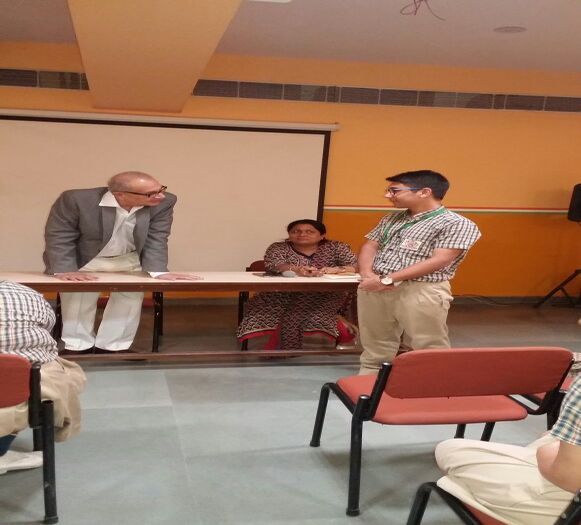An interaction with the Chairman on the philosophy of religions.
Julius Caesar once said, Experience is the teacher of all things. On 16 August, 2016, our School chairman Mr. Prafull Goradia, with his vast experience as industrialist, parliamentarian and above all as a visionary, interacted with the students of classes XI and XII (Humanities) on a most poignant topic of Indian democracy - In the present times of communal frenzy, can Brahmanicalism and Mohammedanism coexist?
The talk was very pertinent as Hinduism and Islam are the third and second most popular religions in the world. They differ in many respects - including idol worship, monotheism and their history. We live in a country where Hindus constitute the majority at 79% and Muslims the largest minority at approximately 14%.
Mr. Goradia began the discussion by asking us to introspect on Gandhjis immortal song Ishwar, Allah tero naam sabko samati de bhagwan and consider whether it is in accordance with the religious ethos of people especially those who neither have the will nor the inclination to equate their God and Goddesses with their counterparts from other religious groups.
[gallery link="file"]
During the discussion, Divya Kshitij Srivastava of XI-D asked Mr. Goradia why animals have been brought into the scene of religion. He explained that certain animals are worshipped and condemned because of historical milieu. Muslims dont like the pig because they are probably dirty and this conception overtime expanded and ended up into a state of ill-feeling about the animal and its existence. Similarly, Hindus worship the cow. The reason for this is that since the later Vedic times, the cow has been a prized possession as it provides people with dairy products and acts as a means of survival. So, various religions have different reasons to like or dislike an animal.
Bedanto Sen of XI-D also posed a question, What is the idea connected with Judgment Day amongst Hindus and Muslims? Mr. Goradia was delighted to see that the students were interested in knowing the fundamental differences between the two religions. He explained that the idea of Judgment Day is seen in Islam but not in Hinduism. Hinduism says that the human has infinite existence whereas Islam talks of the Day of Judgment [Qayammat]. According to him, the idea of burying the dead amongst the Muslims is based on this idea of the Day of Judgment.
Ritwik Arora of XII-C was curious to know whether it is possible to have a uniform civil code in our country. Mr. Goradia supported this answer by giving the example of Goa where the Uniform Civil Code exists and has been successful.
A major part of the discussion was about the approach of peaceful coexistence as prevalent in some countries, such as Switzerland. Here, all religious sects have entered into agreements whereby they keep the interest of the whole society above their religious ideals. So, Roman Catholics agree that they will not encourage Jesuits as they are known for conversion and this would affect the demographic ratio. Muslims agreed that they will not have minarets and loud speakers for azaan as it will affect the serene ambience of the Swiss cantons.
The message of the discussion was loud and clear. If we want to contribute to the progress of our country, then we need to keep our religious thoughts and differences at home and work together towards a bright future.
Tushar Seth [12-C].













